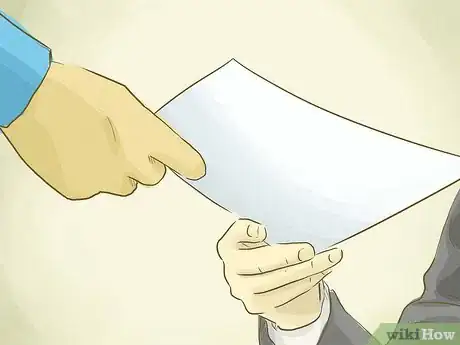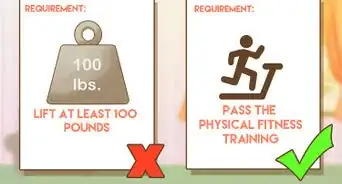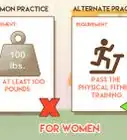This article was written by Jennifer Mueller, JD. Jennifer Mueller is an in-house legal expert at wikiHow. Jennifer reviews, fact-checks, and evaluates wikiHow's legal content to ensure thoroughness and accuracy. She received her JD from Indiana University Maurer School of Law in 2006.
There are 15 references cited in this article, which can be found at the bottom of the page.
This article has been viewed 33,819 times.
Most employers in the United States are subject to the Age Discrimination in Employment Act (ADEA), which prohibits discrimination against people over 40 on the basis of age in hiring, firing, layoffs, pay, benefits, promotions, demotions, performance reviews, or any other condition of employment.[1] The ADEA provides you with the right to sue your employer in federal court if you are a victim of age discrimination in the workplace. However, you should keep in mind that age discrimination cases are exceedingly difficult to win, and that age discrimination tends to be more difficult to prove than discrimination based on other characteristics such as race or gender.[2] [3]
Steps
Filing an EEOC Charge
-
1Go to the EEOC website. The Equal Employment Opportunity Commission is responsible for enforcing the ADEA and other federal laws that prohibit employment discrimination.
- Although the EEOC doesn't accept charges or complaints against employers through its website, you can use the website to learn more about federal employment discrimination laws and find out if you have a legitimate case against your employer.[4]
- If you have a claim under federal law, you must first file a charge with the EEOC before you can file a lawsuit in federal court. In most cases, you must wait for the outcome of the EEOC's investigation of your charge before you have the right to file a lawsuit.[5]
- However, although you must file a charge with the EEOC first, you don't have to wait until the investigation is complete before you file a lawsuit under the ADEA.[6]
-
2Use the online assessment tool. The EEOC provides a tool for you to determine whether you're eligible to file a charge.[7]
- Federal law gives you 180 days from the date of the action or event that gave rise to your charge.[8]
- If your case involves more than one act, each act will have its own deadline. Therefore, if the 180 days has passed with respect to the first act, you can't include that act in your charge – although you may be able to include subsequent acts for which the deadline hasn't passed.[9]
- If you're alleging an ongoing pattern rather than referencing specific events or actions, however, the deadline typically applies to the last incident that occurred, and you may include all of them.[10]
- Deadlines and procedures also may differ depending on whether you're employed in the private or government sector, and what type of employee you are.[11] [12] [13] [14] The assessment tool evaluates all of these contingencies for you to determine your eligibility based on the information you provide.[15]
Advertisement -
3Complete the intake questionnaire. If the online assessment tool has confirmed you're eligible to file a charge, you must complete an intake questionnaire to begin the EEOC charge process.
- Filling out and submitting the intake questionnaire doesn't mean you've filed a charge. Rather, the intake questionnaire provides the EEOC with the information necessary to evaluate your case and determine whether there is a remedy for your situation under federal law.
- You can download a copy of the intake questionnaire from the EEOC's website. The questionnaire includes additional information about the charge process and instructions for filling out the questionnaire.
- Before you sit down to complete the questionnaire, you may want to take a look at the questions asked so you can gather any documents or information you'll need.
- Keep in mind that it may take several hours to complete the questionnaire.
- You can call 1-800-669-4000 if you have additional questions or need more information, but understand that the EEOC doesn't take charges over the phone. However, the EEOC representative can answer your question and forward details about your case to the field office nearest you for evaluation.[16]
-
4Locate the nearest EEOC field office. To begin the charge process, you must submit your completed questionnaire to the field office closest to you or your employer.
- You can find the nearest location using the map the EEOC has available on its website at http://www.eeoc.gov/field/index.cfm.
- Keep in mind that while you technically can submit your intake questionnaire anywhere, it will be evaluated more quickly if you take it to the location nearest your employer, since that office would be more likely to investigate the charge.[17]
- The most efficient way to file your questionnaire is to take it into the field office personally. Be prepared to have an interview with an EEOC representative on the spot.[18]
- You also can mail your form, or a letter containing the same information that would be included on the questionnaire. However, keep in mind that if you send a letter, it may delay processing since typically the EEOC will mail you back an official questionnaire form to complete.[19]
- If you're mailing a letter, make sure your letter includes basic contact information for you and your employer, the approximate number of employees your employer has, a short description of what took place and when, and why you believe those actions constitute age discrimination.[20]
-
5Complete your interview. If the EEOC determines, based on the information you provided in your intake questionnaire, that an investigation is warranted, a representative will contact you.[21]
- The EEOC representative will ask you questions and seek further information about any acts or incidents you discussed in your intake questionnaire.
- If you're appearing for your interview in person, you may want to bring along any documentation you have of the discrimination, such as emails or notices you received from your employer.[22]
- If the closest field office to you is still a considerable distance away and you can't make the trip, your interview may be held over the phone after you've mailed in your questionnaire.[23]
- You should hear back from the EEOC within 30 days after you mail your completed questionnaire. If 30 days pass and you don't hear from anyone, you should call the EEOC at 1-800-669-4000 to check on the status of your charge.
Deciding to File a Lawsuit
-
1Analyze the legal requirements. Before you file a lawsuit in federal court, you must meet the prerequisite requirements to file a lawsuit under the ADEA.[24]
- Keep in mind that your state also may have a law prohibiting age discrimination, in which case you may have to file a charge or complaint with your state agency as well. In many states, however, if you file a charge with the EEOC it is treated as dual-filed with the requisite state agency.[25]
- While other types of discrimination require that you wait until the EEOC has completed its investigation before you file a lawsuit, if you have an age discrimination case you don't have to wait that long.[26]
- Under the ADEA, you only have to wait 60 days after you file your charge to file your lawsuit. However, if you do decide to wait until after the EEOC has completed its investigation, you must file your lawsuit within 90 days of the date you receive notice that the EEOC has ended its investigation.[27]
- If you decide to file your lawsuit before the EEOC concludes its investigation, you can request a Notice of Right-to-Sue from the EEOC, but keep in mind that formal notice is not required under the ADEA.[28]
-
2Assess the value of your case. While it can be difficult to estimate, having a reasonable understanding of what you stand to gain and what you stand to lose can help you decide whether it's worth it to file a lawsuit.
- While how much you stand to recover will depend to a large extent on your actual losses (including past and future wages), the overall value of your case will depend on the strength of your evidence. A case with unquestionable "smoking gun" type evidence will be worth more than one in which your evidence hinges on rumors or statements by third parties.[29]
- Keep in mind that age discrimination cases typically have a lesser value than cases involving other types of discrimination because the ADEA does not allow for punitive damages, which are intended to punish the discriminatory employer and prevent such discrimination from happening in the future.[30]
- You also must understand that all cases are different. Proving age discrimination is very difficult. For this reason, an employee who wins an age discrimination lawsuit and is awarded a significant amount of money will be big news. However, this doesn't mean you can assess the value of your own case based on what that other employee received.[31]
-
3Hire an experienced employment attorney. Due to the difficulty of proving age discrimination, you must hire an employment attorney with experience litigating age discrimination lawsuits if you intend to come out a winner.[32]
- To find an experienced attorney, check with your local bar association. Many bar associations have databases online that allow you to search for attorneys in your area based on their specialty and years they've been in practice.
- Once you find a few attorneys in the area, do a little background research on each of them by checking their websites and professional records. The local bar's website generally will give you information regarding whether an attorney has been subject to professional discipline, and the attorney's own website may provide information on the cases that attorney has won and examples of awards obtained.
- Make sure you find someone with experience in age discrimination specifically, rather than just employment discrimination generally. Age discrimination is its own area of law within the broad category of employment discrimination, and has its own rules that don't apply to other types of discrimination.
-
4File your complaint. To begin your lawsuit, you must file a complaint in the federal court that has jurisdiction over your employer.
- Your complaint will identify you and the employer you're suing, explain the factual basis for your age discrimination lawsuit, and list the damages you're seeking from the company to remedy that discrimination.[33]
- Once you file your complaint, evidence-gathering and litigation will begin in earnest. You shouldn't be surprised if your employer sends over a settlement offer when it receives your complaint. In all likelihood, this will be a low-ball offer significantly lower than the amount of damages you requested in your complaint.
Building Your Best Case
-
1Choose your legal theory. You can argue an age discrimination lawsuit based either on disparate treatment or disparate impact.
- Under the disparate treatment theory, you must demonstrate that you were singled out and treated differently than other employees because of your age.[34]
- If you use a disparate impact analysis, you must show that the policy or practice your employer enacted had a disproportionately negative impact on older employees.[35]
- Keep in mind that in most cases, disparate impact is far more difficult to prove than disparate treatment, in part because you must show that many older employees were negatively impacted by the policy or practice, not just you.
-
2Understand the legal standard. The standard for evaluating age discrimination claims is different than that used for other types of employment discrimination.
- If you're using a disparate treatment theory, you must prove that your age was a motivating factor in the act your employer took or the decision that was made.[36]
- This is a significantly higher standard than in other discrimination cases, where you only have to prove that the discriminatory reason (race, gender, etc.) was a contributing factor. If you're claiming age discrimination, you must prove that it was the motivating factor behind your employer's decision.[37]
- Disparate impact claims also have a relatively high standard, because the employer can defeat the claim by showing that the policy or practice was based on some factor other than age, and was an objectively reasonable way to achieve a legitimate business purpose.[38]
-
3Gather evidence. The type of evidence that is most valuable will depend on the legal theory you've chosen.
- Evidence of disparate treatment hinge on proof of the motives of your employer – evidence that often can be very difficult to get.[39] The main reason it's hard to get this information is because most employers are careful and seldom will outright state a discriminatory motivation.
- However, if you had an email from your boss to someone in human resources that said, for example, "We have to fire John, he's too old for his job and I know a 20-year-old fresh out of college who will do the same thing for half as much money," that would be evidence of disparate treatment.
- Evidence of disparate impact tends to be based more on patterns and statistics.[40] You probably won't win a disparate impact age discrimination case if you are the only employee who was negatively affected by the policy or practice, or if significant numbers of younger employees also were negatively affected.
- In terms of disparate impact, the strongest evidence would show that younger employees benefited from the policy or practice, while all employees over the age of 40 were negatively impacted.[41]
- You want to get as much information as possible about the employment decision that forms the basis of your claim, both by your own means and through discovery. Any reasons for the decision should be well documented.
- If your employer gave you reasons for the decision, you should consider whether you were given any prior warning of the problem before the decision was made. For example, if you were terminated, review your own records to determine if the issue for which you were fired was something your employer had warned you about in the past.
- If you have an employee handbook or other documents that explain various policies and procedures, analyze the employer's actions to see whether the company policies were followed.
-
4Talk to co-workers. If anyone at your workplace witnessed any acts or incidents that you believe constituted age discrimination, you can find out if they would be willing to testify as a witness on your behalf.
- Additionally, you may need witness testimony from other employees who were negatively impacted by the policy or practice on which your claim is based – even if they weren't impacted as much as you were or don't intend to file a lawsuit of their own.
- Particularly if you're suing under a disparate impact theory, testimony from other co-workers over the age of 40 may be necessary to best prove that the policy or practice constitutes age discrimination in violation of the ADEA.[42]
- If your lawsuit alleges disparate treatment, the testimony of any employees who witnessed statements that indicate age was a motivating factor in the act you allege was discriminatory may prove vital to your lawsuit's success.
- For lawsuits based on disparate impact, you may need employees from the human resources department or supervisors in charge of implementing the policy or practice to provide testimony on your behalf.
- How the policy was described and defined, and how much discretion supervisors had in implementing the policy, can be crucial to a disparate impact claim.[43]
- For example, your employer may have instructed your supervisor that he or she needed to lay off 10 people in your department. If guidelines were provided for the supervisor to determine who should be laid off, those guidelines should leave little wiggle room for interpretation.[44]
- Favoring employees who are "flexible" or "willing to learn" can be indicators of age discrimination because they show a preference for younger employees over older ones.[45]
-
5Participate in mediation. At some point during the course of your litigation, you may have the opportunity to resolve your dispute through mediation.
- You may opt to participate in mediation voluntarily, or it may be ordered by the court in which you file your complaint.[46]
- Through mediation, a neutral third party works with you and your employer to attempt to negotiate a settlement to the dispute. The procedure is much less formal than a trial, and you have more control over the outcome.[47]
Warnings
- Before filing a lawsuit, it is recommended you speak with an attorney. The Age Discrimination in Employment Act allows exceptions known as a "bona fide occupational qualification" which allows employers to legally discriminate against age even if you're 40 or over. Some examples are Police Officer, School Bus driver, or Commercial Airline Pilot.⧼thumbs_response⧽
References
- ↑ http://www.eeoc.gov/laws/statutes/adea.cfm
- ↑ http://abcnews.go.com/Business/story?id=7876578&page=1
- ↑ http://fortune.com/2012/05/18/why-you-probably-cant-win-an-age-discrimination-suit/
- ↑ http://eeoc.gov/employees/howtofile.cfm
- ↑ http://www.eeoc.gov/employees/lawsuit.cfm
- ↑ http://www.eeoc.gov/employees/lawsuit.cfm
- ↑ http://eeoc.gov/employees/howtofile.cfm
- ↑ http://eeoc.gov/employees/timeliness.cfm
- ↑ http://eeoc.gov/employees/timeliness.cfm
- ↑ http://eeoc.gov/employees/timeliness.cfm
- ↑ http://eeoc.gov/employees/coverage.cfm
- ↑ http://eeoc.gov/employees/count.cfm
- ↑ http://eeoc.gov/employees/coverage_federal.cfm
- ↑ http://eeoc.gov/employees/coverage_private.cfm
- ↑ http://eeoc.gov/employees/howtofile.cfm
- ↑ http://eeoc.gov/employees/howtofile.cfm
- ↑ http://eeoc.gov/employees/howtofile.cfm
- ↑ http://eeoc.gov/employees/howtofile.cfm
- ↑ http://eeoc.gov/employees/howtofile.cfm
- ↑ http://eeoc.gov/employees/howtofile.cfm
- ↑ http://eeoc.gov/employees/howtofile.cfm
- ↑ http://eeoc.gov/employees/howtofile.cfm
- ↑ http://eeoc.gov/employees/howtofile.cfm
- ↑ http://www.nolo.com/legal-encyclopedia/suing-age-discrimination.html
- ↑ http://eeoc.gov/employees/charge.cfm
- ↑ http://www.nolo.com/legal-encyclopedia/suing-age-discrimination.html
- ↑ http://www.eeoc.gov/employees/lawsuit.cfm
- ↑ http://www.eeoc.gov/employees/lawsuit.cfm
- ↑ http://www.workplacefairness.org/valuing_your_case
- ↑ http://www.workplacefairness.org/valuing_your_case
- ↑ http://www.workplacefairness.org/valuing_your_case
- ↑ http://www.nolo.com/legal-encyclopedia/suing-age-discrimination.html
- ↑ http://www.nolo.com/legal-encyclopedia/suing-age-discrimination.html
- ↑ http://www.hg.org/article.asp?id=35677
- ↑ http://www.hg.org/article.asp?id=35677
- ↑ http://www.hg.org/article.asp?id=35677
- ↑ http://fortune.com/2012/05/18/why-you-probably-cant-win-an-age-discrimination-suit/
- ↑ http://www.hg.org/article.asp?id=35677
- ↑ http://www.hg.org/article.asp?id=35677
- ↑ http://www.hg.org/article.asp?id=35677
- ↑ http://www.hg.org/article.asp?id=35677
- ↑ http://www.hg.org/article.asp?id=35677
- ↑ http://www.nolo.com/legal-encyclopedia/age-discrimination-lawsuits-based-disparate-impact.html
- ↑ http://www.nolo.com/legal-encyclopedia/age-discrimination-lawsuits-based-disparate-impact.html
- ↑ http://www.nolo.com/legal-encyclopedia/age-discrimination-lawsuits-based-disparate-impact.html
- ↑ http://www.nolo.com/legal-encyclopedia/suing-age-discrimination.html
- ↑ http://www.nolo.com/legal-encyclopedia/suing-age-discrimination.html
- ↑ http://www.hg.org/article.asp?id=35677














-Step-24.webp)










-Step-24.webp)






































